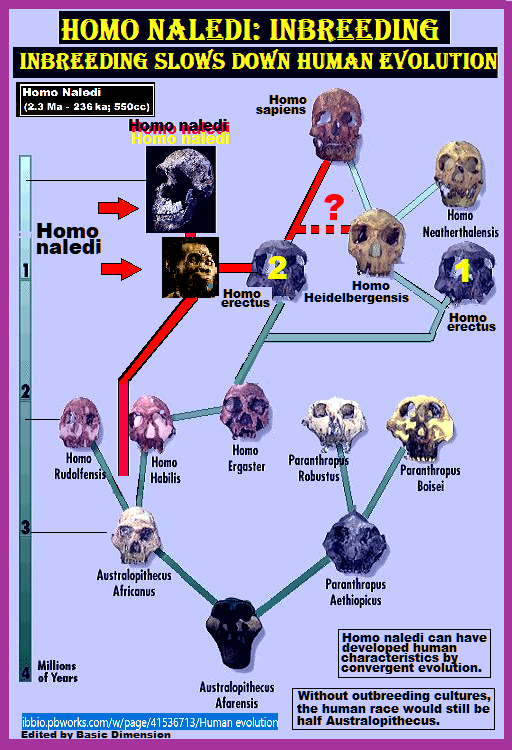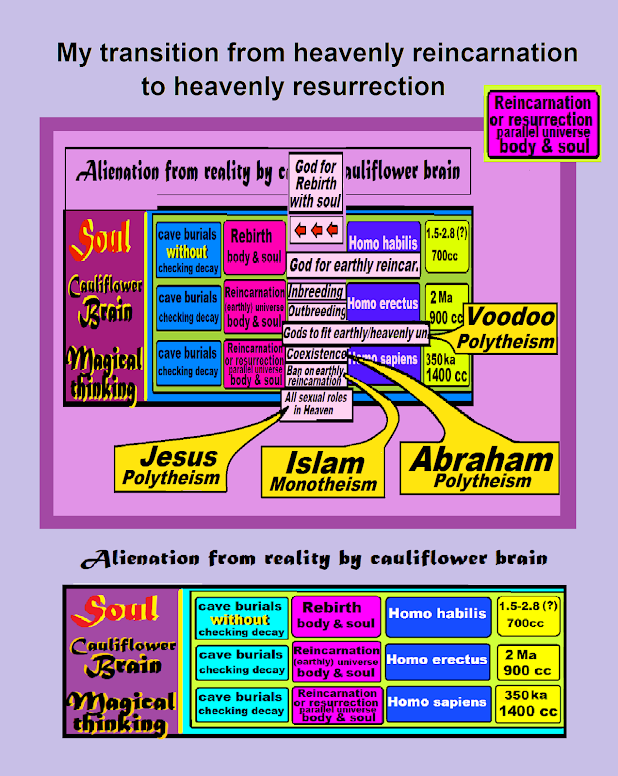Basic Dimension
If we expect a religion to last no longer than 5000 years, then 236,000 years is too long ago to see Islam as successor of Homo naledi, though both are inbreeding religions:
Then, how is the hypothetical link between both species passed? Bipedal evolution is an endless alternation of two primordial instincts, taking place only in bipedal primates. It's the battle between inbreeding and outbreeding. Between monotheism and polytheism.
Where outbreeding is the primal sexual breeding instinct in the animal world and inbreeding just an artificial replacement for bipeds that nevertheless always has the lead:
Chimpanzees and bonobos, our closest relatives, have the generalized male Alpha model, a mixed and stabilized model of inbreeding and outcrossing, resulting in genetic diversity and outbreeding:
The remarkable fact of Homo naledi is its balanced breed. All individuals looked the same, just like a balanced breed of dog:
Autosomal recessive disorders must have been eliminated since Naledi's origin about 2.3 million years ago:
On the other hand, would Homo naledi be the end product of millions of years of outcrossing, then his 'human characteristics' were found or will be found in his predecessors. But until now we did not found these perfect human limbs and hands earlier. And then there would also be more variation as with Homo erectus (2.2 Mya; 900cc):
So, we really may guess Homo naledi as an inbred population, hiding in the African wilderness for millions of years. His human features in hands and limbs must really be his, and not have come about through convergent evolution with Homo erectus:
Homo naledi was thus never in convergent evolution with Homo sapiens:
And if Homo naledi really did develop our advanced limbs and hands, then he probably must have been very intelligent too and the small brain hypothesis must be wrong. We need to look more at the skull endocasts:
We, Homo sapiens, are sick magical thinkers with a cauliflower brain:
And that's why we need to rewrite human evolution:
The religious way of life of Homo naledi matches this appearance. He was a logical thinker without the junk of the soul and reincarnation:
1: It is completely dark in the Rising Star Cave and Homo naledi had no light. Dinaledi chamber is about 100 meters away from the entrance and everything was completely dark and invisible.
2: Homo naledi probably thought the deep chute to Dinaledi chamber was the gate to the underworld
3: Earlier, he figured out that all new life sprang from the soil of the underworld.
4: He threw all dead bodies into the chute of the underworld to renew their bodies for rebirth in the upperworld. It was the same as burials in the ground but better without worms and insects.
5: In Dinaledi chamber he took renewal for granted, since he was not able to check the degree of decomposition of the bodies. Remember the body of Jesus was gone also after rebirth.
6: Apparently, he expected the deceased to be reborn as offspring within their own renewed bodies and without reincarnation into other bodies.
7: Hence, he needed no auxiliary hypothesis of body and soul.
8: Because
9: Two million years was Homo naledi the Christians ahead.
10: This all means the Rising Star Cave gives us an extremely rare example of religion in human prehistory and offers a glimpse of the state of the art of the religion of Australopithecus.
11: This means,
(77) Homo naledi from rebirth to reincarnation
So, we may conclude the discovery of the Rising Star Cave is serendipity, a matter of good luck in science (as the discovery of penicillin). The Rising Star Cave must be seen as an extremely rare field experiment that satisfies scientific requirements for research into rebirth. And guess what, it is quite possible this i
Assumption 655 has been changed into 656 in (428)Assumption 656: (655 rewritten). In the second sense of Rebirth, Homo naledi transcended the spiritual value of Reincarnation (Homo erectus). Because in the latter the soul was placed into a foreign body, by which the deceased lost his physical identity (his own body). While the ultimate conception of Rebirth was a complete rebirth of the original body, possibly within any woman of the tribe. And because naledi did not believe in the soul they were fully reborn with their original physical identity.
So their new parents weren't necessarily their biological parents, because the newborn's DNA didn't have to match their parental DNA, because it only had to come from the tribe as a whole, where everyone looked perfectly alike. Newborn DNA could come from deceased anywhere in the tribe.
As a consequence they also lost inbreeding on family level and behaved adulterously, like bonobos, although the tribe as a whole remained pure inbred as a calibrated dog race. This led to outbreeding within a closed balanced inbred population.
As said, Homo naledi didn't believe in the soul, which was not necessary, because the God of Darkness did all the work. Therefore, Rebirth of Homo naledi results in a complete physical rebirth of the deceased. That's why Rebirth transcends Reincarnation.
Then, in this second phase of Rebirth, the bond with the parents had been completely released and the fetus could be born anywhere in the Homo naledi population. Homo naledi could not verify this because all individuals looked alike, like a balanced dog race.
Assumption 654: Physical resurrection is the superlative of inbreeding.
Homo naledi knew three kinds of breeding:
1: Inbreeding by Genetic Immortality:
The first form is well known inbreeding what we now call 'cousin marriages'. They saw parental traits returned in the offspring. But they also feared that the individual itself had been lost as an entity. That's exactly Genetic Immortality, standard animal religion in which DNA is past to the offspring but the individual dies.
2: Rebirth by the God of Darkness (fertility stress):
And since not all intercourse manifested in births, Homo naledi further assumed a force that placed the fetus in the mother's womb after the act. And so they came up with the God of Darkness, who decided on conception.
Inbred populations were plagued by fertility stress, what means too few births to sustain the species. Perhaps DNA was lost underground so that the God of Darkness couldn't turn it into fetuses. And so they decided to pile up all the dead in Dinaledi Chamber, so that the God of Darkness could at least find them. Therefore the dead were put in the ground as deep as possible. In fact, their first scientific experiment was born of fertility stress.
So if the number of births equaled the number of deaths, then this proved the existence of the God of Darkness who previously simply could not find the DNA of the deceased.
3: Physical resurrection as superlative of inbreeding:
But the experiment took on a second interpretation over time, because tracking how many deaths were delivered and how many births this resulted in also meant that the deceased themselves were integrally reborn as fetuses when incoming deaths and outgoing fetuses went hand in hand. It therefore no longer mattered which womb the fetuses ended up in. Further, they all looked alike and were indistinguishable. So, they were unable to prove their theory. But never mind, and their possible decision to physical resurrection on Earth could theoretically have been the end of their inbreeding culture. But Homo naledi's physical resurrection did retain the link with breeding, the birth process, just like reincarnation.
So Homo naledi was eager to know:
1: whether the God of Darkness really existed and
2: whether Rebirth existed as physical resurrection on Earth, without magical assumptions of the soul or reincarnation. And in case of physical resurrection of the individual the inbreeding culture itself became obsolete and fetuses could be expected in whatever womb. So the link with ancestors was lost, which was not a problem because individuals of Homo naledi were almost identical by million years of extreme inbreeding.
The Soul and Reincarnation:
And Homo naledi was right because for them the soul and reincarnation were unnecessary assumptions where they saw everything shoots out of the ground in the real world.
Physical resurrection outclasses reincarnation:
If Homo naledi really looked for Rebirth as physical resurrection, then he outclassed Reincarnation, in which the individual himself was not replicated but only his soul was placed in a foreign body.
But of course, unlike Homo naledi, we see Rebirth and the God of Darkness also as forms of magical thinking. The point here, however, is that Homo erectus with his cauliflower brain (900cc) strayed further from reality than Homo naledi with his 550cc.
But what's the point? Homo naledi really aligns with Islam, which believes in physical resurrection in heaven, not from the God of Darkness, but from Allah. It is about the same, but without the unnecessary assumption of the soul, the fallacy of Homo erectus.
A further difference, however, is that for Islam physical resurrection in Heaven is not linked to the birth process, but that this remains the case for Homo naledi, who thus retains the link with the sexual breeding instinct.
But both, Islam and Homo naledi were right. Physical resurrection is the superlative of inbreeding, which only meant to replicate males somewhat in their offspring. While physical resurrection delivers exact replicas of human beings without inbreeding. Homo naledi and Islam thought they possibly found the egg of Columbus.
Finally, it should be noted that Homo naledi's first interpretation of Rebirth is associated with a sexual instinct: Inbreeding. But had he gone into physical resurrection, he would have lost that instinctive bond with inbreeding and could be born in any mother. But that does not alter the fact that the link with breeding itself would have been preserved.
The Muslim faith, however, has fallen into a mixture of two religions: inbreeding from polytheism (idols) versus physical resurrection (monotheism), where resurrection is just a meaningless word. Which means that in Islam reincarnation by inbreeding will always remain stronger than resurrection, just a word.
Conclusion: Homo naledi could have been much wiser than we think.

.png)


.png)




























.png)


